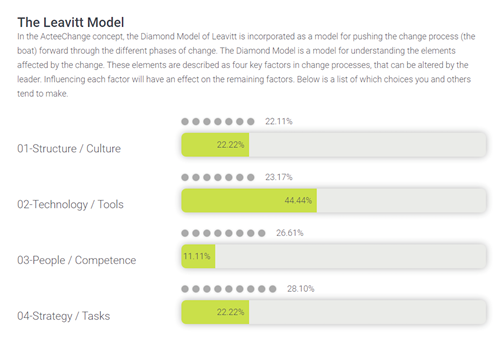
Technology Trends Within Change
Whitepaper By Ida Bjørnsbo & Leif Sørensen
In this month’s whitepaper, we will focus on data from the Actee game ‘Destination CRM (short)’ which is a shortened version of the original game. This is a change game with more than 5.000 participants and is about implementing a new customer relationship management (CRM) system which will affect everyone greatly in the game.
Us Vs. ITU Students
One of Actee’s key focus areas is change management – how to implement a change and getting the stakeholders on board the change mission.
In this month’s whitepaper, we will focus on data from the Actee game ‘Destination CRM (short)’ which is a shortened version of the original game. This is a change-game with more than 5.000 participants and is about implementing a new customer relationship management (CRM) system which will affect everyone greatly in the game.
In this white paper, we correlate the +5.000 games played with a group of 200 ITU students playing the same game in times of COVID.
The data is displayed as seen by consultants after a facilitated game session, and there has been no further analysis of the data.
Leavitt’s Diamond Model
In the game, players can choose to use choices build on Harold Leavitt’s Diamond Model as its main framework. Leavitt’s Diamond consists of four elements – Structure, People, Tasks and Technology – which Leavitt describes as the most imperative factors in an organization. All four factors have mutual interactions and direct effects on each other, meaning if changes are made in one of the four factors, all of them will be influenced. Therefore, when implementing a change, all four elements must be taken into consideration for the implementation to be a success. If these factors are not considered when planning change, there will be many unforeseen implications for which you would be prepared for, had you used the framework. For a change to become successful according to Leavitt, all four elements need to be modified to the changes.
In Actee’s change games, the Leavitt framework is incorporated as a model for pushing the change process (the boat) forward through the different phases of change.

Destination CRM (short)
The data presented below illustrates 200 ITU students’ results of playing the game as the green bars, and 5.000+ players from all spectrums of the professional workforce as the grey dots above.


The First Factor – Structure

IT students and the workforce show a very similar pattern, both having 22% choosing to place their focus on this area. The structure element includes not only the hierarchical structure, but also the communication, relationships, workflows, and coordination patterns. It is clear, that when any changes happen the mentioned factors all need reiterating. Without a focus on structure, the whole organization would be a mess and impossible to navigate. The fact that both the workforce and IT students agree on the level to pick this element, shows the general knowledge on the importance of structure, culture, and communication. The same level can occur by coincidence, if so, both students and workforce know eighter intuitively as they play, if they have some knowledge from theory, or they might have been introduced as part of the game session.
The Second Factor – Technology

IT students apply almost the double focus to this element in comparison to the workforce. We believe that this is because IT students have been introduced to a substantial variety and thereby gain a broader understanding of what new technology is available and how it can be applicable in a variety of different circumstances. Furthermore, they are presumed to know, what additional value you can generate by implementing these different technologies, and they, therefore, see this element as the most imperative on – especially in the current times of digitalization, we have all seen the importance of staying updated and informed about the newest technology in the industry.
Moreover, being a student currently, learning about technology, we believe they are much more updated on how to apply these technologies to be as beneficial as possible, and that they are able to implement said technologies with more ease, than one who is unknown to the knowhow.
If we additionally look at this choice through the cognitive bias – confirmation bias, it proves how we are more likely to notice, focus and apply the knowledge that supports our existing beliefs. This bias proves, that when using system 1 thinking by Kahnemann (kahnemann, 2011), IT students are more likely to deem technology as the most important factor in Leavitt’s diamond model, as it confirms their views.
For the general workforce, this factor is weighed as the second-lowest focus area.
We like to ask questions like, ’does experience in the workforce change your perception of technology?’ Or is it simply because applying new technology is a resource-heavy change process, that can seem unmanageable to most if they have no experience with this kind of process?
Or is the game story just telling everyone to not use new technologies when we are implementing a new CRM system and is, therefore, a relatively smart “change” strategy (Rick Maurer 2012)?
The fact is that we have 23% of the playing workforce who choose to use new technologies as one of the prime tools to move the change process in the game. What seems unclear is why! All change theory suggests the exact opposite, finish one change before you start a new one!
Is the most used change theory getting out of sync with our rapidly changing world and its increasingly wicked problems that need action faster than ever before?
The Third Factor - People

IT students apply less than a quarter of their focus on this area in contrast to the workforce. This is the second-highest focus element for the workforce. Our presumption is that the workforce knows that people are the most valued resource.
Let us try to exemplify this statement, when entrepreneurs finding investors, the common misconception is that the investor only looks at the potential of the product or service. When the reality is, that the investor is equally interested – if not more - in the team behind the idea. If an investor believes in the product, but not the team, then she will not invest. If she on the other hand believed in the team, then the idea is subordinate. As most managers and leaders can tell you, a good team can almost always turn around the trickiest of situations. (Jesper Buch 2012)
For people having been in the workforce for a longer period of time, this becomes clear, but for students with a focus on IT, it can be difficult to see what human resources can do, that technology cannot. Additionally, being in the workforce, you gain insightful first-hand knowledge on how unsatisfied employees work – and it is not efficient, and it is not without resistance. What makes dissatisfied employees especially problematic, is that unhappy employees are contagious. If you do not keep your human resources satisfied, you could face major issues before you know it.
The Fourth Factor – Tasks

IT students and the workforce are getting closer together, but the workforce applies the largest focus on this element on average. We assume that the workforce is represented heavily by more strategic positions, such as managers, who need to constantly be looking forward, simultaneously staying updated with their team of employees. Being in a managing or leading position, it is of utmost importance to be strategic, otherwise, you would blindly be leading the blind. Without a strategy, you have no progress, you cannot plan what tasks must be done and you are therefore not prepared for the future. In other words, it is better to be on the bus, than to constantly be running after it, trying to catch up. It is both demotivating and much more effort.
If we again apply the conformation bias here, it is not surprising that people who are used to think strategically, plan out tasks, set deadlines etc. are more likely to weigh ‘Tasks’ as the most imperative factor.
However, IT students are still placing 22% of their focus on this, which is also not as surprising as one might think. The reason for this is acutely very logical - when you are an IT student, you are so because, well firstly hopefully you are fond of IT, but also because you believe that technology will continue to be an increasingly contributing factor in the future. So, focusing on technology can be seen as a strategic move.
This, I think, is a great example of the complex this model really can be, how the four factors intertwine, and the clear lines between them are getting more and more blurry.
Let´s sum up
Students are more likely to add new technology and focus less on the people side when they make choices in the games.
If we look at this as a correlation between two teams or at this as a leadership profile element and not between unrelated groups (IT students and workforce). Then L&D might be able to support more directly on a team level, but also on a personal level since each player gains a personal theory profile after playing a game. This profile can be measured against colleagues, against teams, against companies who also have played the same game, or measured against the line of business. Then data becomes a tool to drive the learner to play more and learn more, but more importantly, it becomes a strategic tool to support specific teams or individuals on how to or not to add new technology in a change process.
Let us know what you think!
Reference List:
Actee, 2020, Data Module. Accessed: November 2020, <https://app.actee.com/#/app/statistics>
Buch, J. & Bakmand, M. 2012, Kick-Ass. People’sPress.
Kahneman, D. (2011) Thinking Fast and Slow. 2nd edition, Lindhardt & Ringhof, Egmont.
Toolshero, 2020, Leavitt’s Diamond. Accessed: November 2020, <https://www.toolshero.com/change-management/leavitts-diamond/>
Rick Maurer, 2020, Changes Without Migraines. Accessed: November 2020, <https://www.rickmaurer.com/home/index.php>
Check Out The Data Module Here